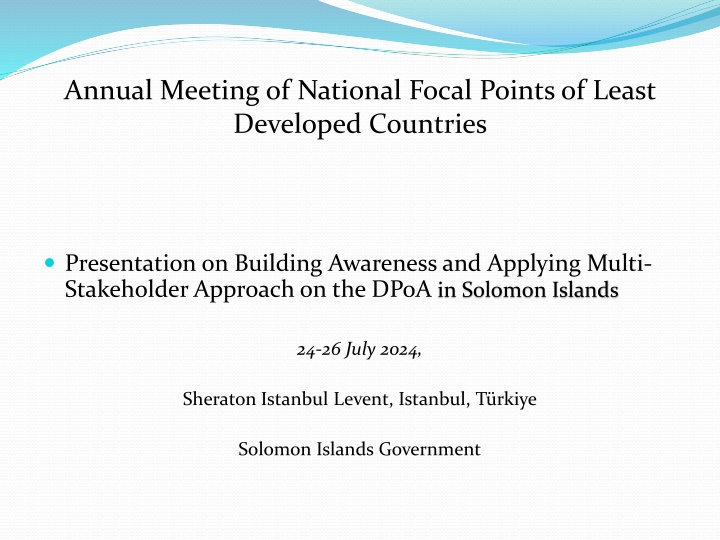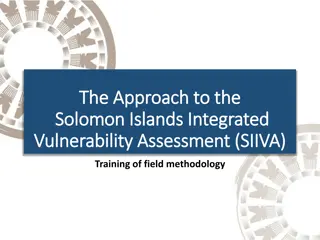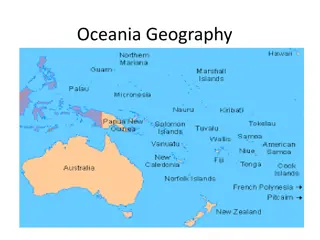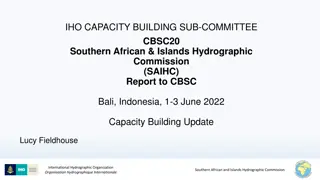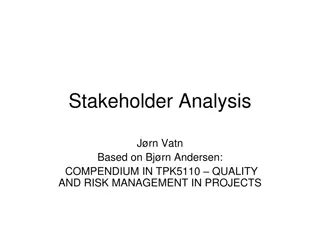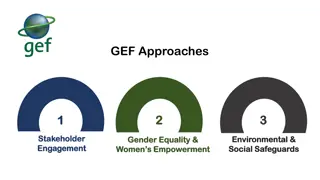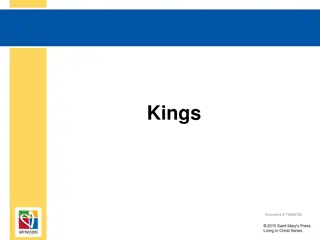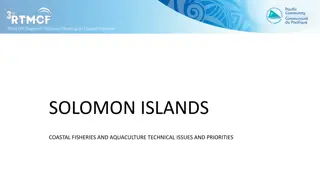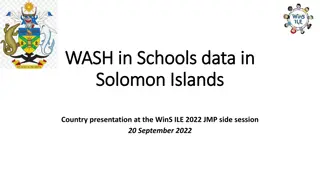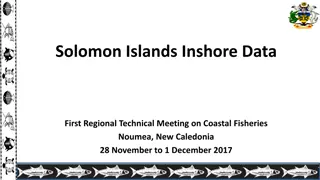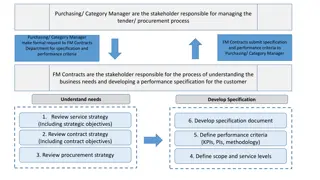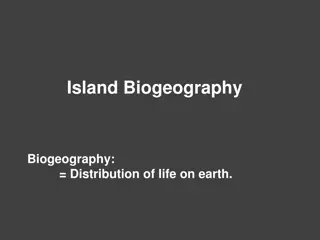Building Awareness and Applying Multi-Stakeholder Approach in Solomon Islands
Annual Meeting of National Focal Points of Least Developed Countries on implementing Doha Programme of Action into the National Development Strategy (NDS) 2016-2035 in Solomon Islands. Focus on strategic vision, long-term planning, and key objectives integrating SDGs. Emphasis on monitoring, performance indicators, and regional priorities for sustainable development and inclusive growth. Leveraging technology, innovation, and gender equality while addressing climate challenges for resilient economies.
Uploaded on Mar 12, 2025 | 0 Views
Download Presentation

Please find below an Image/Link to download the presentation.
The content on the website is provided AS IS for your information and personal use only. It may not be sold, licensed, or shared on other websites without obtaining consent from the author.If you encounter any issues during the download, it is possible that the publisher has removed the file from their server.
You are allowed to download the files provided on this website for personal or commercial use, subject to the condition that they are used lawfully. All files are the property of their respective owners.
The content on the website is provided AS IS for your information and personal use only. It may not be sold, licensed, or shared on other websites without obtaining consent from the author.
E N D
Presentation Transcript
Annual Meeting of National Focal Points of Least Developed Countries Presentation on Building Awareness and Applying Multi- Stakeholder Approach on the DPoA in Solomon Islands 24-26 July 2024, Sheraton Istanbul Levent, Istanbul, T rkiye Solomon Islands Government
Solomon Islands National Development Strategy (NDS) 2016-2035 Basis for implementation of the Doha Programme of Action / SDGs Solomon Islands has integrated the DPoA to the NDS 2016-2035 A 20 year NDS 2016-2035 was developed by the Solomon Islands Government. Provides a strategic vision & longer term planning framework with greater stability and continuity; Lays the foundations for recovery and long term sustainable development. Has 5 key long term NDS Objectives Has 15 Medium Term Strategies Fits into the 2030 Agenda which the Doha Programme of Action (DPoA) is part of and the Solomon Islands is committed to implement at the country level.
Implementation, Follow-up and Monitoring DPoA requires comprehensive follow-up and monitoring measures at national, regional and global levels-mutually complementary and reinforcing. National level arrangements important including national ownership and leadership. Likewise, DPs expected to integrate DPoA into their Cooperation Frameworks and monitor the delivery of their commitments. NDS has a M&E Framework Performance Indicators - at both macro & program/project level MNPDC continues to works closely with National Statistic Office on key macro Performance Indicators and monitoring of DPoA/SDGs. Program/Project Performance Indicators essential for line ministries to monitor program and project performance to be selected in consultation with line ministries, based on NDS and program frameworks Performance of Partner Programs also needs monitoring
NDS Objective SDG s DPoA for LDCs Antigua and Barbuda Agenda for SIDS (ABAS) Regional Priorities A. Resilient economies NDS Objective 1: sustained and inclusive growth SDG 8: Good jobs and economic growth SDG 9: Innovation and Infrastructure Key Focus Areas for Action 3: Supporting structural transformation as a driver of prosperity; ICT Economic diversification Trade and investment Tourism Ocean-based economy Key Focus Areas for Action 4: Enhancing international trade of least developed countries and regional integration; Key Focus Areas for Action 1: Investing in people in least developed countries: eradicating poverty and building capacity to leave no one behind; Objective 2: Poverty alleviated across the whole of Solomon Islanders, basic needs addressed and food security improved; benefits of development more equitably distributed SDG 1: No Poverty SDG 2: No hunger SDG 5: Gender equality SDG 6:Clean water and sanitation SDG 7: Renewable Energy SDG 10: Reduced inequalities -Sustainable Inclusive Economic Growth - Food security and nutrition - Gender equality - Water and sanitation - Sustainable Energy - Social Development Objective 3: All Solomon Islanders have accessto quality health and education SDG 3: Good health SDG 4: Quality Education Key Focus Areas for Action 2: Leveraging the power of science, technology, and innovation to fight against vulnerabilities and to achieve the Sustainable Development Goals; Cervical Cancer B. Safe and prosperous societies Strengthen health systems Strong institutions Achieve gender empower youth and leave no one behind multidimensional equality, Key Focus Areas for Action 5: Addressing climate environmental recovery from pandemic and building resilience against future shocks for risk- informed development; change, degradation, the COVID-19 sustainable
NDS Objective SDG s DPoA for LDCs SAAntigua and Barbuda Agenda for SIDS (ABAS) MOA Pathway Priority C. A secure future Renewable energy Water-food-energy security Resilient infrastructure Transportation connectivity Climate and Security Regional Priorities Objective 4: Resilient and environmentally sustainable development with effective disasters risk management, response and recovery SDG 13: Climate Action SDG 14: Life below water SDG 15: Life on land Key Focus Areas for Action 5: Addressing climate change, environmental degradation, recovery from the COVID-19 pandemic and building resilience against future shocks for risk- informed sustainable development; Climate Change Fisheries and D. Environmental integrity and Planetary sustainability Urgent action on climate change Conservation sustainable use of the ocean and its resources Restore biodiversity Mainstream Reduction and Disaster Risk Strong institutions Objective 5: Unified nation with stable and effective governance and public order SDG 16: Peace and Justice Key Focus Areas for Action 6: Mobilizing international solidarity, reinvigorated global partnerships and innovative tools and instruments: a march towards sustainable graduation. SDG 17: Partnerships for the Goals. DPoA: Key Focus Areas for Action 6: Mobilizing international solidarity, reinvigorated global partnerships and innovative tools and instruments: a march towards sustainable graduation. How do SIDS get there? Access to finance Scaling-up climate finance Strengthening data collection Science, technology, innovation and digitization Productive populations Partnerships A more effective UN in support of SIDS
Building Awareness and Applying Multi-Stakeholder Approach on the DPoA in Solomon Islands Remains a challenging area yet for the country, as country is geographically spread, 9 Provinces on different Islands Requires a lot of costs associated to reach out with the message to everyone Requires whole of government approach (24 respective line ministries), 9 Provincial Governments, State Owned Enterprises (SOEs), Private sector, NGOs awareness Continuous integration of DPoA into the NDS ME Performance Framework Continuous review of NDS 2016-2035 implementation, opportunity to integrate the DPoA and ABAS into the NDS Medium for awareness includes: Radio awareness, print newspapers, workshops, provincial visits to provinces and rural communities, brochures and billboard awareness including visual material contents. SI is schedule to graduate in December 2027, will also need awareness sharing to all stakeholders in the country. Currently, working on our SI LDC STS.
Collaboration with Bilateral and Multilateral Development Partners The need to work collectively with our Bilateral Development Partners remain crucial in achieving Solomon Islands National Development Strategy (NDS 2016-2035). Collaborative approach with Multilateral Development Partners remain very crucial in the Solomon Islands awareness program. Visibility and efficiency of UN System and its programs within the region as well as its relevance with the UN Bodies in Country. National Interest through NDS must remain the priority of both bilateral and Multilateral development engagements. Avoid overlap and redundant program of actions, effective coordination with respective government line ministries
Challenges of monitoring DPoA within context of implementing and monitoring the 2030 Agenda Effective coordination and monitoring of the international and national development frameworks at government level remains a challenge. Limited knowledge and awareness about the DPoA Implementation and Reporting Process and the vertical alignment of policies and plans at the global level. Limited number of Policy and Strategic documents as opposed to operational and program level planning. Weak dissemination of information (Policies and Strategy Documents) within and across organizations Different time frame of Policies and Strategies to DPoA timeline. Inadequate central development and policy database. Quality and comprehensiveness of National Policies and Strategic Documents. Planning orientation to projects and activities level without clear long term targets as required for SDGs. Weak central coordination of National Policy and Strategic Plans implementation. Weak horizontal integration and alignment amongst national policies and strategies. Weak integration of policy and strategy implementation amongst key stakeholders. Bureaucratic and administration interface to policy and strategy implementation. Availability of available financial resources to implement DPoA and SDGs
Opportunities of monitoring DPoA Continuous Mainstreaming Process of DPoA into National Policies and Strategies. Setting clear Baseline, Targets and Indicators for DPoA and SDGs. Policy Strategic Framework and Priorities. Institutional Arrangements for Implementation. Create greater understanding and familiarization on the DPoA to stakeholders in the provinces, rural communities, etc. Create effective networks and links between SIG, development partners, civil society and private sector. NDS M&E Framework currently being revised in a SDG Mapping exercise and serves for DPoA implementation and monitoring. Evidence base Aid Information Management System (AIMS) implementation to track development assistance is currently on progress.
Conclusion Implementation of the DPoA is generally positive but with mix results. DPoA has aligned well to NDS Objectives and enabled Development Partners to work together with Government and align mutual objectives for implementation. Learning from the IPoA implementation best practises and lessons learnt, to implement the DPoA, Our mid-term review report on (IPoA) sets the basis to help to raise awareness on DPoA goals and targets. Serves as a benchmark for country to address targeted policies in the remainder of the DPoA framework.
